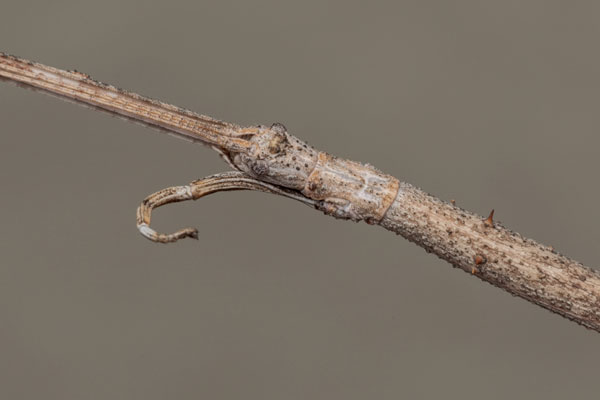Some fundamental principles of phasmid breeding are summarized below. Further detailed information on certain specific breeding aspects can be found in the corresponding sections (e.g. Food Plants, Facilities for Breeding, Incubation, etc.).
Basics
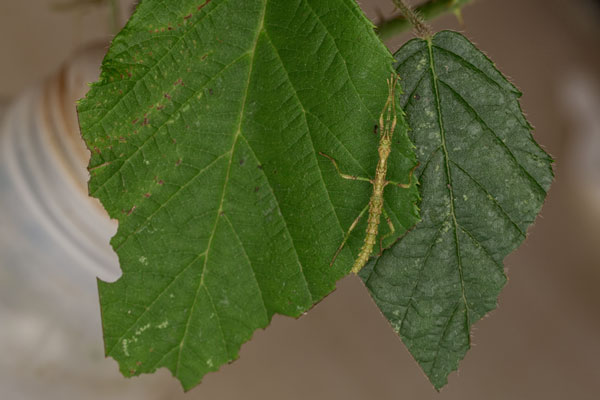
- For freshly hatched nymphs, cut off the leaf margins all around the food plant leaves. They will start to feed much easier and more readily. Usually one will recognize that they start feeding where the leaf margin is cut off, and not where the leaf margin is still intact (see pic).
- It is also possible to keep freshly hatched nymphs with older nymphs so that they find leaves which are already partially eaten by others. But, see the next point...
- Best to keep nymphs separate from the adults. This is mainly to protect them during the very crucial phase of molting. Also keeping nymphs and adult in the same cage usually results in damaging overpopulation.
- Cages, egg incubation containers and containers for the food plants are cleaned regularly. A basic cleanliness is a must, yet without becoming too meticulous about it.
- Temperature:
- In most of our breeding cages, temperatures range between 20 - 25°C.
- If possible, avoid that temperatures rise above 27°C or drop below 18°C for a prolonged time.
- A nocturnal drop in temperature is both natural and healthy.
- During summer heat wave it can be difficult to keep the temperature low. Often closing the window shutter (during the day) and turning off all heat sources in the room (including lightening) can help to avoid the worst.
- We experienced more fatalities, when temperatures raise to around 30°C or even more.
- Humidity:
- Do not keep phasmids too moist, they are no fish.
- A humidity level of about 65 - 75% RH is good enough for most phasmid species (even those from rainforests).
- In fact, even freshly hatched Phyllium nymphs do very well if kept at a moderate humidity of 60 - 70% RH. Just experience shows the adult Phyllium males are better kept at a somewhat higher humidity of ≥ 80 % RH.
- Consider that the humidity within a cage like a Faunabox (or similar cage with reduced aeration), is easily 15 - 20% higher than in the room wherein the cage stands. Especially if there is moist paper on the cage floor.
- Other species gotta be kept at a lower humidity level (≤ 65% RH). For example species from rather dry or even arid environments, like Bactrododema, Bacillus, Pijnackeria, Achrioptera fallax.
- Usually, it is enough to spray water just 2 - 3 times per week at the most. Or less if the humidity in the cage is high anyway. Unless of course when the humidity (within the cage!) is very low (< 60% RH).
- If you have to spray rather often, then let the water dry up completely before spraying again. Do not keep phasmids constantly wet.
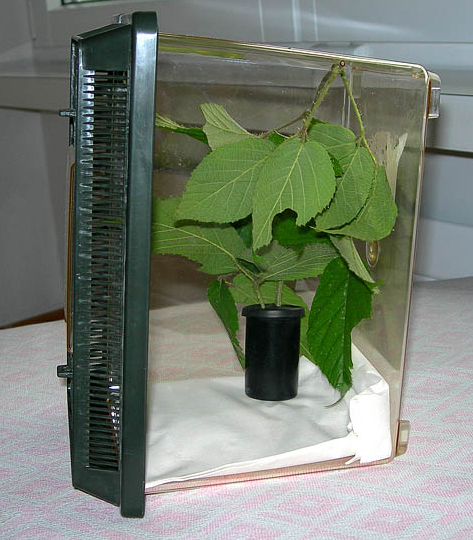
Avoid overpopulation
- As far as possible, keep only one species per cage. This makes it much easier to screen and oversee the development of a culture and it is much easier to avoid overpopulation and hybridization.
- Keeping just one species per cage is also an essential step in keeping our cultures pure. Especially when it comes to species of the same genus.
- We should be aware that compared to the natural situation, even the biggest cages are overpopulated.
Problems caused by detrimental overpopulation:
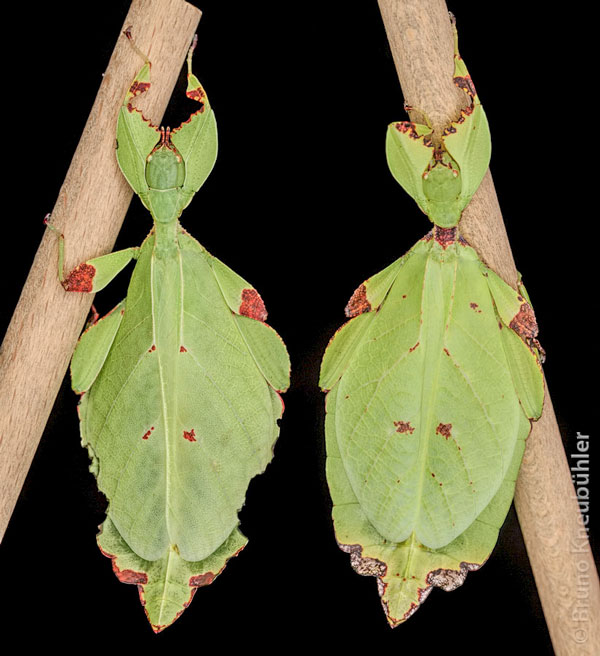
The Phyllium on the left side is showing signs of cannibalism. Photo by Bruno Kneubühler. - Obviously, phasmids in overpopulated cages are more stressed, which badly hampers their development and health.
- Problems during moulting (ecdysis) are quite frequent. This often leads to crippled specimens, with missing legs or even badly deformed bodies. Such deformations can be lethal.
- Phasmids tend to chew on each other if kept in an overpopulated cage. This is a sort of "cannibalism", which is especially common amongst Phyllium. 4) Phasmids in badly overcrowded cages tend to be weaker and smaller in size than specimens which grew up in commodious cages - or those in the wild.
- Use your own sensitivity to the needs of another living being to appraise whether your cages are overcrowded or not. Being considerate of the needs of other living beings is even in this hobby a more than welcome virtue.
- Keep nymphs separate from adults.
- When nymphs are kept separate from adults, then one has a much better overview of the nymph's condition and development.
- Then nymphs are much better protected during the moulting process, when they are very vulnerable.
Lightening
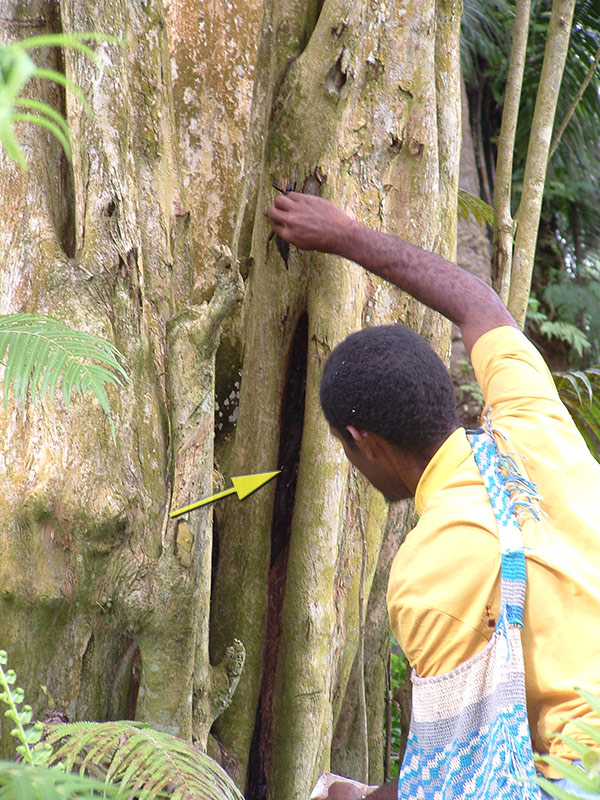
- Although many phasmid species do not need much light, still some light should be present in our breeding rooms.
- For example, Achrioptera and Phyllium thrive better when there is enough light in their cages. They do even like direct sunlight and they will crawl out into the sun from a shady place. In the cage, they are often on the side which has the most light.
- But of course, one has to be very careful with direct sunlight, otherwise a cage (especially partially closed cages like Faunaboxes) will overheat very quickly.
- If you do not have enough natural light available in your phasmid room, then it is advisable to install some additional artificial lighting. We use LED floodlights, which use a minimal amount of energy.
- Some phasmid species (e.g. Phyllium, Achrioptera, Trychopeplus) hatch in broad daylight - usually in the early morning hours. This implies that a day-night cycle (photoperiod) is beneficial or even needed for proper embryonic development for at least some if not many phasmid species.
- Then there are also species for which (day-) light plays a marginal role. These are ground-dwelling species (e.g. Heteropteryginae), which often hide out under leaves or in tree holes during the day. But even such species should not be kept in complete darkness. Their behaviour to hide during the day implies that (day-) light does provide them with some relevant orientation, which could well be of biological importance. The pic from New Britain (PNG) shows the day-hideout of Eurycantha in a (dark) tree hole.
What to begin a culture with - eggs or nymphs/adults?
Regularly we hear that phasmids do not really thrive well or even die quickly when they are passed from one breeder to another. A possible explanation for this is, that older nymphs/adults become quite adapted (not to say "addicted") to the micro-climatic conditions they are exposed to. This seems to lead to acclimatization problems when a breeder offers his phasmids to another breeder, as most probably the micro-climatic conditions will be different at their new home. On the other hand, the propensity/capability of young (especially freshly hatched) nymphs to cope with various micro-climatic conditions is better than that of older nymphs or even adults.
It is not the best idea to ship spare males around the world unless it is the only way left to save a culture from becoming parthenogenetic. First of all, this is a great stress for them (have you ever seen how they treat parcels at the post office....?), and then you have no idea how old the male is.
For these reasons, we recommend starting or "renew" a culture with eggs, from a reliable breeder. And in our eyes, a reliable breeder is someone who knows about the history of his culture, and who is using the full scientific name including the provenience affix.
Another advantage of starting with eggs is that phasmid-related diseases will not spread easily from breeder to breeder. Our cultures are more or less "mono-cultures", and it is to be expected that over time diseases (caused by viruses, microbes or fungi) will appear. Such diseases will more likely be spread via infected phasmids, while the chance that eggs are infected might be lower. One can even wash/rinse eggs underwater when they arrive, thus further reducing the danger of introducing potentially harmful diseases.
Water
Chlorinated water:
- In some areas, the tap water is still sanitized or preserved by adding chlorine. Do not use chlorinated (tap) water, as it is potentially hazardous for insects as well as it is for humans. If you do not know how your tap water is being preserved, then ask your local water supplier.
- In case your tap water is chlorinated then use bottled water, for the sake of your and your pet's health.
- When boiling water for some time, then chlorine partially evaporates. But just partially!
Demineralized water:
- It may seem to be very convenient to use demineralized water (often produced by reverse osmosis) as spraying water causes it does not leave lime stains on the cage glass. However such water is mildly acidic and has proven to be hazardous when used as drinking water, causing it to negatively affect various physiological aspects. For more info about this, search for "demineralized water drinkable". The bottom line is, do not use such water for your phasmids.
Mould
- It is almost unavoidable that in some phasmid cages mould will grow. Mould multiplies by spores, which are produced by the billions. These spores are so lightweight that even the slightest breeze carries them away. This results in an increased concentration of mould spores in the air of a breeding room. Our teammate Bruno Kneubühler has measured this, as he is working in a microbiological laboratory.
- Thus mould spores end up in our lungs, and they are a potential human health risk. The more spores the bigger the health hazard.
- Without overreacting, still breeders should be aware of this and take possible measures to minimize mould growth in their cages, and thus minimize their intake of mould spores.
- This is another very good reason to keep the humidity in your phasmid room at a moderate level. Mould starts growing easily at ≥ 75% RH.
Minimize disturbances
- A living room or a bedroom are not ideal places for breeding phasmids. In such places there often is quite a lot of commotion. Light goes on and off, lights are on well into the night, people rush in and out, music ...
- Music at deafening volume might be fun for the two-legged listener, but it is stressful for phasmids.
- Some species might be quite tolerant towards a wide range of conditions and disturbances. But even though they breed rather well, this does not mean that they are not stressed.
- If you fail to breed some species, which is otherwise considered to be an easy-to-breed species, then you may wanna have a look at your general breeding conditions.
